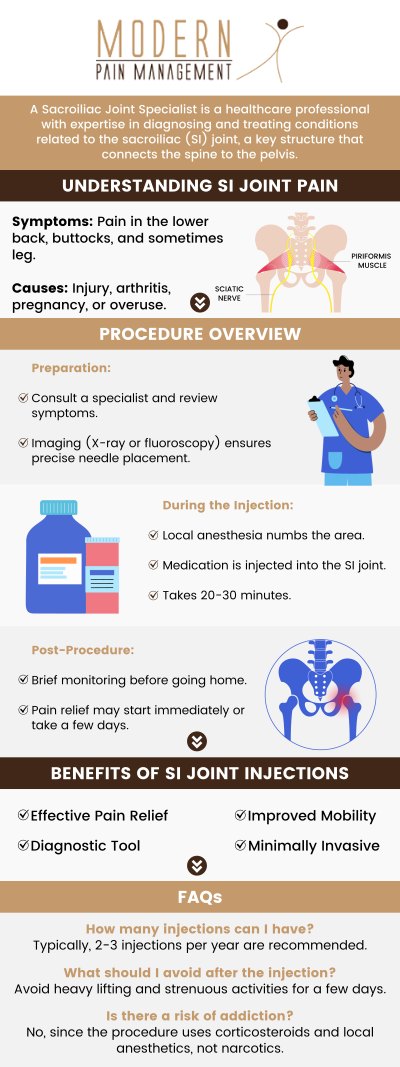Sacroiliac (SI) Joint Pain Relief Q&A
An injury is the main cause of sacroiliac pain. Your ligaments could become too loose or too tight as a result of a fall, work injury, or automobile accident. With the use of efficient techniques and treatments, Dr. George Atallah, D.O. and his team can assist in enhancing the flexibility and strength of your SI joint. For more information, contact us or schedule an appointment online. We have convenient locations to serve you in Houston TX and Sugar Land TX.




Table of Contents:
How can I get immediate relief from SI joint pain?
How do you treat an inflamed SI joint?
How long does it take for an inflamed sacroiliac joint to heal?
What causes SI joint flare-ups?
There are a range of at-home and treatment options to provide some immediate relief from your SI joint pain, depending on the severity.
Pain in your SI joint can be treated by your doctor, but you can also relieve the pain by moving around at home. It’s good to be active, but start slowly, such as walking, swimming, or riding a stationary bike a few minutes a day. There are some movements that can make SI joint pain worse and prevent healing from taking place. Be careful not to bring your knees to your chest, do sit-ups, twist, or bend your knees at the waist. Until you’re feeling better, running should be avoided. In addition to reducing swelling around your SI joint, ice packs can also numb your pain.
Wait at least 30 minutes before applying another one after applying one for 20 minutes. Keeping yourself from overdoing it is important, but bed rest isn’t usually the best course of action. The amount of activity you should perform while you are experiencing SI pain will depend on the cause. It is often beneficial to walk lightly to ease your aches and speed up the healing process. On the first or second day that you’re in pain, rest in bed for a few hours. Maintaining good posture can reduce lower back stress. Consider limiting how often you shift your weight to one side of your body if you have SI joint dysfunction. You may need to seek medical treatment if nothing seems to be taming your SI joint pain. Medication, injections, or physical therapy or chiropractic appointments can be prescribed by them. They may also be able to help you with alternative treatments.
Physical therapy is usually beneficial for people with sacroiliitis. The treatment strengthens and stabilizes the muscles surrounding your sacroiliac joints. The full range of motion of your sacroiliac joints is also made easier by physical therapy.
NSAIDs are sometimes prescribed by doctors to manage pain associated with sacroiliitis in its early stages. Sacroiliac joint inflammation and pain may be reduced by injecting steroids into the joints. If sacroiliac joint injections provide temporary relief from pain, radiofrequency ablation may be considered. Radio waves are used to heat a small area of nerve tissue to prevent it from sending pain signals.
There are different levels of sacroiliac joint pain, depending on the severity of the injury and its cause. Joint pain in the SI occurs suddenly and usually clears up within a few days to a few weeks. Pain in the SI joint persists for more than three months; it may be constant or worsen during certain activities.
When your SI joint becomes inflamed, you experience pain. SI joint flare-ups can be caused by a number of factors. When you play sports or fall down, you could injure it. The area might also be affected by activities like jogging that regularly impact the area. It is possible to suffer from SI joint pain if you take uneven steps when you walk. In some cases, you may feel pain when the ligaments that hold your SI joint together are damaged, causing the joint to move abnormally. There is a possibility that arthritis can cause the problem. SI joints are susceptible to damage caused by ankylosing spondylitis, a disease that affects the spine. As you age, the cartilage over the SI joint slowly wears away. It is also possible to experience SI joint pain while pregnant. Your body releases hormones that loosen your joints and cause them to move more, leading to changes in joint movement.
Our compassionate and supportive doctors at Modern Pain Management have expertise in treating sacroiliac joint pain and can provide you with relief. We have convenient locations to serve you in Houston TX and Sugar Land TX. For more information, please contact us or book an appointment online. We serve patients from Houston TX, Sugar Land TX, Pearland TX, Jersey Village TX, Missouri City TX, Stafford TX, and Richmond TX.
ADDITIONAL SERVICES YOU MAY NEED




